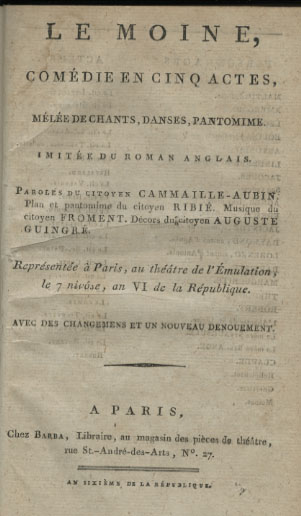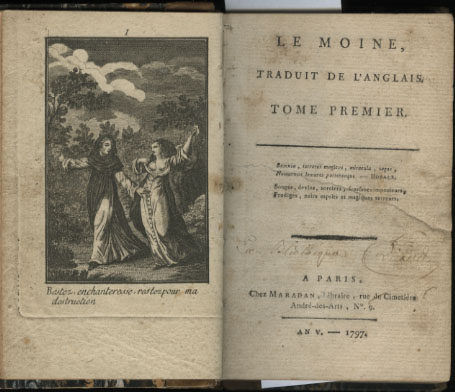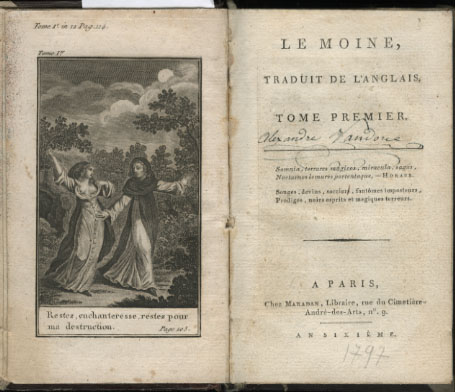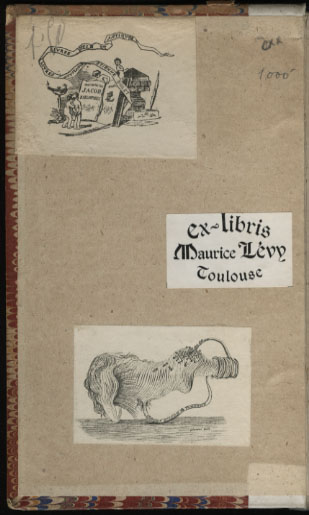In a previous post Nicole Bouché, Director of the Small Special Collections Library, related the story of how the Maurice Lévy Collection of French Gothic arrived at its permanent home under Grounds. Thanks to the magnificent gift of the Sadleir-Black Collection of Gothic Novels received in 1942, U.Va. has world-renowned holdings in the English Gothic novel, now wonderfully augmented by the Lévy Collection. Here is a brief peek at a few of its riches.
At the core of the Lévy Collection are its many contemporary French translations of English Gothic novels. Here, for instance, is a listing of the Ann Radcliffe works to be found in the Lévy Collection:
- Les châteaux d’Athlin et de Dunbayne. Paris: Testu, 1797.
- Le couvent de Sainte Catherine, ou les moeurs du XIII° Siècle. Paris: Renard,1810.
- Eléonore de Rosalba, ou le confessionnal des pénitens noirs. Paris: Lepetit, 1797.
- La forêt, ou l’Abbaye de Saint-Clair. Paris: Denne, 1796.
- La forêt, ou l’Abbaye de Saint-Clair. Paris: Maradan, 1798.
- La forêt, ou l’Abbaye de Saint-Clair. Paris: Lévy, 1880.
- L’italien, ou le confessionnal des pénitens noirs. Paris: Maradan, 1798.
- L’italien, ou le confessionnal des pénitents noirs. Paris: Lévy, 1873.
- Julia, ou les souterrains de Mazzini. Paris: Maradan, 1798.
- Julia, ou les souterrains du château de Mazzini. Paris: Lévy, 1897.
- Les mystères du château d’Udolphe. Paris: Lévy, 1874.
- Le tombeau. Paris: Lerouge, 1812.
- Les visions du château des Pyrénées. Paris: Lévy, 1896.
For those English readers who could not afford the cost of a multi-volume novel, publishers offered Gothic fiction in shorter, less expensive form. The castles of Montreuil & Barre was first serialized in The Lady’s Magazine during 1797-1798, then printed in chapbook form (“price sixpence”) with a lurid hand-colored frontispiece to attract purchasers. Special Collections already possesses two early chapbook editions of this work, courtesy of the Sadleir-Black Collection, and the Lévy Collection contributes a third, published by W. Mason and dating to ca. 1820. This copy is in its original blue paper wrappers, which feature on the inside a list of the various chapbooks available at “Mason’s Pamphlet Warehouse” on Clerkenwell Green.
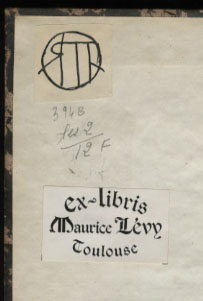 Because many of the Lévy volumes are two centuries old, they display interesting evidence of ownership and use by multiple generations of readers and collectors. Two works in the Lévy collection, for instance, bear the booklabel of noted artist Henri de Toulouse-Lautrec (1864-1901). It is shown here (above Maurice Lévy’s booklabel), pasted into a copy of the intriguingly titled Miss Glamour, ou les hommes dangereux (Paris, an IX [1800/01]). Styled on the title-page as a ‘free translation from the English’ by Théodore-Pierre Bertin, the original English novel has yet to be positively identified. Perhaps Bertin, who self-published this very rare edition, was actually its author?
Because many of the Lévy volumes are two centuries old, they display interesting evidence of ownership and use by multiple generations of readers and collectors. Two works in the Lévy collection, for instance, bear the booklabel of noted artist Henri de Toulouse-Lautrec (1864-1901). It is shown here (above Maurice Lévy’s booklabel), pasted into a copy of the intriguingly titled Miss Glamour, ou les hommes dangereux (Paris, an IX [1800/01]). Styled on the title-page as a ‘free translation from the English’ by Théodore-Pierre Bertin, the original English novel has yet to be positively identified. Perhaps Bertin, who self-published this very rare edition, was actually its author?
Emanuella, ou la découverte premature (Paris, an IX [1800/01]) is a French translation of Eliza Haywood’s The rash resolve, or the untimely discovery. First published in 1724, decades before the heyday of the Gothic novel in England, its plot nonetheless contains some Gothic elements, and it is interesting to see it revived at this time for the French market. Also interesting is the provenance: this copy bears the booklabels of (at top) prolific author Paul Lacroix (“Bibliophile Jacob,” 1806-1884) and (at bottom) the founder of Surrealism, André Breton (1896-1966). Fittingly, Breton’s arresting booklabel was designed by Salvador Dalí.



